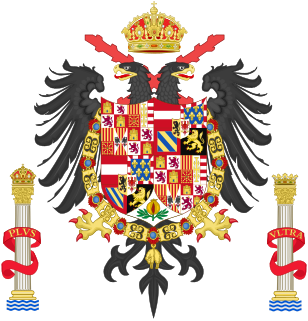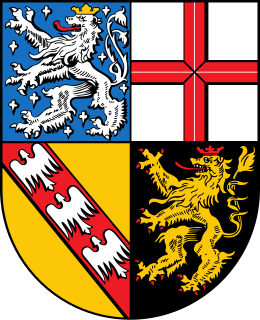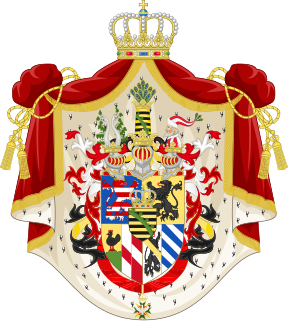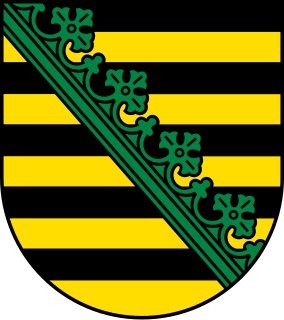 W
WThe coat of arms of Germany displays a black eagle with a red beak, a red tongue and red feet on a golden field, which is blazoned: Or, an eagle displayed sable beaked langued and membered gules. This is the Bundesadler, formerly known as Reichsadler. It is one of the oldest coats of arms in the world, and today the oldest national symbol used in Europe.
 W
WThe coat of arms of Baden comes from the personal arms of the Margraves and Grand Dukes of Baden, the traditional rulers of the region. Following the revolution and abolition of the Grand Duchy in 1918, the arms and griffin supporters were usurped from the Grand Dukes by the new republic to represent the people and country.
 W
WThe coat of arms of the German state of Baden-Württemberg features a greater and a lesser version.
 W
WThe coat of arms of Bavaria has greater and lesser versions.
 W
WThe coat of arms of Berlin is used by the German city state as well as the city itself. Introduced in 1954 for West Berlin, it shows a black bear on a white shield. On top of the shield is a special crown, created by the amalgamation of the mural crown of a city with the so-called people's crown, used in Germany to denote a republic. Berlin's various boroughs use their own emblems.
 W
WThis article is about the coat of arms of the German state of Brandenburg.
 W
WThis article is about the coat of arms of the German state Free Hanseatic City of Bremen and the city of Bremen.
 W
WCharles V, Holy Roman Emperor was the heir of four of Europe's leading royal houses. He first inherited the Burgundian Netherlands, which came from his paternal grandmother, Mary of Burgundy. Charles was then the first sole monarch of Spain, inheriting the kingdoms first united by his maternal grandparents, Isabella I of Castile and Ferdinand II of Aragon. Finally, on the death of his paternal grandfather, Maximilian I, Holy Roman Emperor, he inherited the Habsburg lands in Austria. His coat of arms, representing much of the land he inherited, is blazoned as follows:Quarterly: I and IV grand-quarterly i and iv great-grand-quarterly 1 and 4 gules a three towered castle Or masoned sable and ajouré azure, 2 and 3 argent a lion rampant purpure crowned Or langued and armed gules, ii per pale, dexter per fess, in chief Or four pallets gules, in base gules a cross, saltire, and orle of chains linked together Or and a centre point vert, sinister party per pale argent a cross potent and four crosslets Or impaling barry of eight gules and argent, iii per pale, dexter per fess, in chief Or four pallets gules, in base gules a cross, saltire, and orle of chains linked together Or and a centre point vert, sinister per saltire, 1 and 4 Or four pallets gules, 2 and 3 argent an eagle displayed sable ; II and III grand-quarterly, i gules a fess argent, ii azure semy-de-lis Or a bordure compony argent and gules, iii bendy of six Or and azure a bordure gules, iv sable a lion rampant Or langued and armed gules, overall at the fess point of the quarter an inescutcheon Or a lion rampant sable armed and langued gules impaling argent an eagle displayed gules, armed, beaked, and langued Or ; enté en point argent a pomegranate proper seeded gules, supported, sculpted and slipped vert. Supporters: A bicephalous eagle displayed sable imperially crowned proper in front of a saltire ragulée gules, the whole between two columns argent issuing from the sea proper in base, the one to dexter crowned imperially proper, the one to sinister crowned with the Royal Crown of Spain proper. The motto, PLVS VLTRA or PLVS OVLTRE, wraps around the columns.
 W
WThe coat of arms of the German state and city of Hamburg is a kind of a national emblem. The coat of arms and the flags are regulated by the constitution of Hamburg and law. The colors of Hamburg are white and red. One of the oldest versions of the castle is found on a seal in 1241.
 W
WThe national emblem of East Germany featured a hammer and a compass, surrounded by a ring of rye. It was an example of what has been called "socialist heraldry". It was the only heraldic device of a European socialist state with a ring of grain which does not contain a red star.
 W
WThe coat of arms of the German state of Hesse was introduced in 1949. It is based on the historical coat of arms of the Ludovingian landgraves of Hesse and Thuringia.
 W
WHuwyler is a surname originating from Upper Swabia in the Middle Ages, connecting the region between the current Bavaria and Swiss-German cantons. This surname is still recognized as linked to the Swiss central region with roots in the cities of Risch and Steinhausen.
 W
WThe coat of arms of the German federal-state of Lower Saxony shows a white Saxon steed on a red background.
 W
WThis article is about the coat of arms of the German state of Mecklenburg-Vorpommern.
 W
WThe coat of arms of North Rhine-Westphalia is the official coat of arms of the German state of North Rhine-Westphalia.
 W
WThe coat of arms of Oldenburg is the coat of arms associated with the state of Oldenburg, a county, duchy and then grand duchy that existed between 1101 and 1918. The arms are also associated with the parts of the House of Oldenburg that ruled the state.
 W
WThis article is about the coat of arms of the German state of Rhineland-Palatinate.
 W
WThis article is about the coat of arms of the German state of Saarland.
 W
WThe Saxon Steed is a heraldic motif associated with the German provinces of Lower Saxony and Westphalia, and the Dutch region of Twente.
 W
WThe Coat of arms of the Grand Duchy of Saxe-Weimar-Eisenach was created in 1815 when the area was raised to the title of Grand Duchy, and ended in 1918 with the transition of Saxe-Weimar-Eisenach into the new state of Thuringia. The full grand ducal style was Grand Duke of Saxe-Weimar-Eisenach, Landgrave in Thuringia, Margrave of Meissen, Princely Count of Henneberg, Lord of Blankenhayn, Neustadt and Tautenburg, and this is represented in the arms:In the first quarter, the striped lion of Thuringia; In the second quarter, the arms of the Margraviate of Meissen; In the third quarter, per pale the arms of the County of Henneberg and of Neustadt-Arnshaugk; In the fourth quarter, per pale the arms of the Lord of Blankenhayn (Blankenhain) and Tautenburg; Above all the arms of Saxony, as was tradition for the descendants of the Saxon line.
 W
WThe Saxon Steed is a heraldic motif associated with the German provinces of Lower Saxony and Westphalia, and the Dutch region of Twente.
 W
WThe coat of arms of the present-day German free state of Saxony shows a tenfold horizontally-partitioned field of black (sable) and gold/yellow (or) stripes, charged with a green (vert) crancelin running from the viewer's top-left to bottom-right. Although the crancelin is sometimes shown bent (embowed) like a crown, this is due to artistic license. The coat of arms is also displayed on the state flag of Saxony.
 W
WThe coat of arms of the German state of Saxony-Anhalt represents its historical origins. The land area was formed out of the former Prussian Province of Saxony and the German Free State of Anhalt. The upper part of the coat of arms represents the Province of Saxony with its green crancelin while the lower half shows the bear of the Free State of Anhalt.
 W
WThe coat of arms of Schleswig or Southern Jutland depicts two blue lions in a golden shield. It is the heraldic symbol of the former Duchy of Schleswig, originally a Danish province but later disputed between Danes and Germans. The region has been divided between Germany and Denmark since 1920 and the symbol consequently appears in official heraldry in both countries. It is derived from the national coat of arms of Denmark and has been dated to the middle of the 13th century, first known from the arms of Erik Abelsøn, Duke of Schleswig. Throughout the ages, the design has featured both crowned and uncrowned lions, the lions have occasionally been accompanied by heraldic hearts, and usage between heraldic lions and leopards has shifted. The far most common version was to omit both crowns and hearts and this version has been used exclusively for several centuries.
 W
WThe coat of arms of the German state of Schleswig-Holstein is vertically divided: in the heraldically right field, i.e. left as seen by the viewer, two blue lions are depicted on a golden background, facing the other half. The lions of Schleswig were taken from the coat of arms of Denmark. The heraldically left side is red with the silver nettle leaf of Holstein, an ancient symbol which had been in use with the Counts of Schauenburg and Holstein.
 W
WThe coat of arms German state Thuringia was introduced in 1990. Like the 1949 coat of arms of Hesse it is based on the Ludovingian lion barry, also known as the "lion of Hesse", with the addition of eight mullets.
 W
WThe coat of arms of the Kingdom of Württemberg shows an impalement of the three black antlers that represent Württemberg on the dexter side, and the three black lions passant of medieval Swabia on the sinister side, both on a gold field.